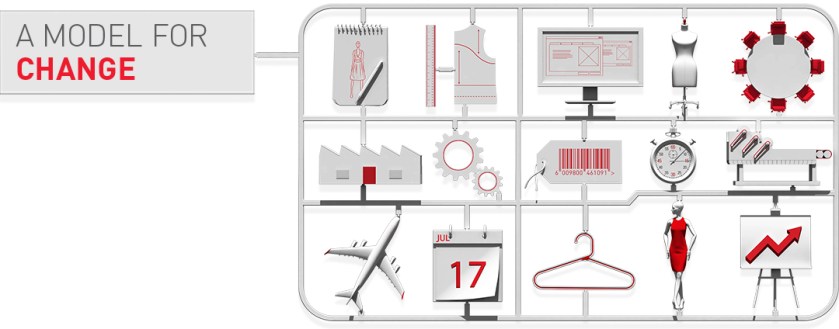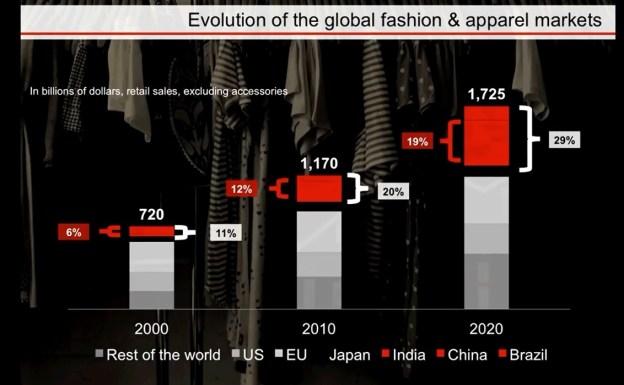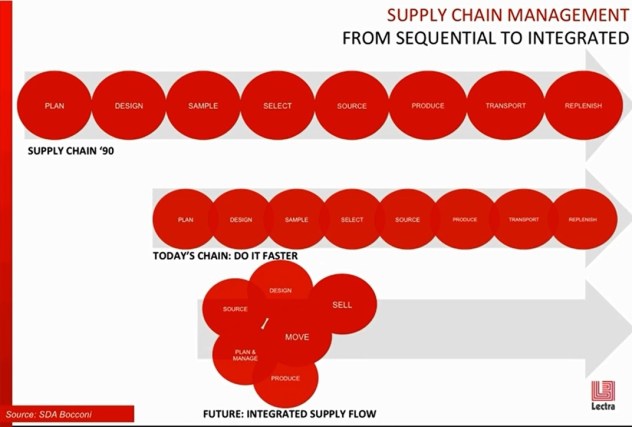As the saying goes, change is the only constant in the fashion apparel industry. According to a newly released market report by Lectra*, “the pace of fashion has never been faster and neither has the pace of change”.
Lectra’s report highlights a few factors driving the changes in the fashion apparel industry:
1. Consumers
Consumers has much more control than in the past, implying the fashion industry can no longer define what to make and sell without taking consumers’ inputs into consideration. Some companies have alter their business models to be completely demand-driven, i.e. allowing integrating all their resources to meet the customized needs of all consumers.
Social and economic changes like internet access and growing prosperity, have also spurred the growth of new fashion markets in emerging countries that had typically been only supplier region, creating new opportunities for western fashion brands and retailers to expand business.
2. Globalization
Historically, local brands dominate local market. However, because of the strategies of geographic expansion and international growth of many fashion brands, in more and more markets, local brands have to face competition from foreign brands. (for example: the Australian fashion industry is worried about the competition from H&M).
But globalization does not reduce diversity and localized consumer preferences. On the contrary, increased internationalization means that populations are more heterogeneous than in the past and retailers have to bring a localized response to individual markets.
3. Technology
New social media and mobile technologies have given consumers the power of instantaneous sharing and buying without restriction of time, place and in many cases, price. The availability of new technologies such as RFID, product life cycle management (PLM) and many other supply chain management tools have also enabled brands, retailers and manufacturers to reduce product development cycle, improve efficiency and better collaborate across the global process.
For example, digital prototyping gives companies the agility they need to adapt to changes in the market and test new products before they start to incur real production costs. PLM facilities the collaboration between design and development departments and breaks the silo mentality that has reigned for so long in the fashion and apparel industry, eliminating bottle- necks that resulted from outdated linear processes and increasing decision making power earlier on in product development.
4. Change of Business models**
In response to the application of new technologies and consumers’ updated demand, companies start to seriously reconsider their business models, especially the process of design, product development, production and distribution. As noted in the report, fashion brands, which have traditionally gone through retailers who sell on their behalf, have developed retail operations with the purpose of capturing a higher percentage of the final sale price and achieving complete control over the presentation, distribution and final price of their merchandise. Many retailers, however, also start to offer more and more private brands and exclusive products that can more effectively segment market and attract targeted consumers.
The traditional manufacturers are also looking for ways to cut costs and increase efficiency because of the pressure from retailers/brands. Manufacturers also have realized that selling directly to the end consumers is the most powerful way to protect revenue. As quoted by the report, roughly 60% of Chinese apparel manufacturers have launched their own brands. Armed with all that know-how, a growing number of Chinese manufacturers are now turning their efforts toward developing an offer for the domestic market and some are even setting their sights abroad. (recall the topic of “upgrading” in our lecture)
*: Lectra is a company which provides fashion-focused technology solutions such as the CAD system and the product life-cycle management (PLM) system.




After reading this article, I think there were some very interesting points made. As a graduating senior and a TMD major, the fast pace world of the textile and apparel industry is one that will never slow down. With the update on new technology and industry progression this will give us, TMD students large knowledge on the world we are heading into. Many businesses that many of us aspire to work at are in a midst of a global change, which we will get to experience. The introduction to new developing retailers are allowing the market to be consumer driven and demand for speed always increasing. At the store Zara, they have current technology that allows them to update their manufacturers of up-to-date sales which allows them to replenish merchandise accordingly with a response to what is actually being sold in stores. The change in manufacturers will also be interesting to see how the Chinese market will change in the next few years which could also change the outlook from the American markets. I think it is important for TMD students to stay up to date on these industry changes because soon we will be living in it.
great comments!
The textile and apparel industry has always been a fast-paced industry that is constantly changing and evolving. Lectra’s report shared factors that are driving these changes in the industry including the consumers, globalization, technology, and the change of business models. Over the years, the textile and apparel industry has seen lots of changes in expansion in globalization and being in the 21st century, technology is constantly improving and evolving. There are new ideas of advertising and marketing ideas, an increase in the idea of social media to promote a given company, etc. I believe that the use of technology has definitely contributed to the expansion of globalization in this industry ultimately for the good of many companies but also the consumers. I also strongly believe that without providing the consumers with what they want, the textile and apparel industry would crash. In the supply chain, consumers are at the end but they are also the most important part of that chain. I am glad that the driving factors for change are recognized and that many companies have taken action to fulfill these needs.
good comment! I am also thinking about the implication of the change on programs like TMD: how to make our curriculum updated and relevant to the 21st century, how to make our students have the right skill and knowledge that can meet employers’ expectations and how to produce high quality scholarships that can drive the industry moving forward.
I agree with both students who have previously posted about this article. I do believe there are both positive and negative implications of increased globalization due to technologies and especially see the impact technological advancements have on business models. As technology progresses it is evident how e-commerce has increased over the years and in some instances are causing storefronts to go out of business. I think it when considering the positive advantages of technology it is interesting to see how it is effecting retailers and foot traffic in stores. Which causes me to wonder how the industry will develop in future years. In response to Sheng’s comment on implications in programs like TMD I wonder how changes in business models and how rapidly e-commerce is expanding will effect or programs (Will there be more website design and e-commerce specific classes?)
Globalization
Historically, local brands dominate local market. However, because of the strategies of geographic expansion and international growth of many fashion brands, in more and more markets, local brands have to face competition from foreign brands. (for example: the Australian fashion industry is worried about the competition from H&M).
It is crazy to see how change is so consistent within the fashion apparel industry, because today in the fashion world it is important to keep up to date with what is trending and popular within season and with that comes change, and a lot of it at that. At this time it is important to see the reason for why fashion is moving at the pace that it is and that is due to technology, consumers, globalization and change of business models. Due to consumers needs and wants companies now a days have to alter their business models to make them more demand-driven because their goal is to keep all of their resources customized to the needs of their consumers. Globalization is also a key concept in the Textile and Apparel industry because it is an international movement that will continue to grow and expand throughout the 21st century. This is something that those in the T&A industry should be very aware of because it is something that will not be prevented. It is beneficial in a sense that it opens new doors and opportunities to several different markets but could also could be a threat to retailers because it brings a lot of competition. That’s why many retailers today like H&M and Zara are known as fast fashion retailers because they have designs made from the catwalk quickly in order to capture the current fashion trends so they have them available for their consumers as soon as possible. I think it is important for TMD/TM students to stay up to date with what is taking place within this industry because soon enough we will partaking with it. And with technology and globalization growing to our advancement who knows where it will take us next.
Good comment! It is critical for our students to realize that T&A is a buyer-driven industry. This is why US-based fashion companies are more interested in reaching out to consumers and understanding their demand rather than expanding the manufacturing capacity. Retailers also control the global apparel supply chain rather than manufacturers.